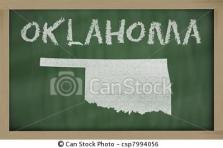As an anti-poverty agency, CAP’s ultimate vision is that the children we serve today move up the economic ladder so that when they are adults their children are not born into poverty. But according to a new study by the Pew Economic Mobility Project, the headwinds facing Oklahomans are particularly strong.
An interactive map shows clearly Oklahoma, along with Louisiana and South Carolina, have worse than average mobility rates on three measures — absolute mobility (residents’ average earnings growth over time), relative mobility (residents’ rank on the earnings ladder relative to their peers), and updward / downward movement along that ladder. Another six states perform worse than the national average on two of the three measures. Interestingly, Texas and Florida, states without income taxes, are two of those six states.
The study looked at average earnings of adults ages 35-39 between 1978 and 1997, and compared them to average earnings of the same sample ten years later. 14% of the Oklahomans experienced absolute mobility, compared to 17% as a national average, and a maximium of 23% in Connecticuit. Relative upward mobility was higher across the board than absolute mobility – 30% in Oklahoma compared to 34% national average and a high of 49%, again in Connecticuit. But, 33% of the Oklahomans experienced downward economic mobility, compared to 28% nationally. And this was before the economic recession of 2008.
The study did not analyze why some states offer better or worse opportunities for residents to move up the earnings ladder. Pew’s larger study on mobility, however, demonstrates that a host of factors including postsecondary educational attainment, savings and assets, and neighborhood povery during childhood — all factors where Oklahoma falls short — matter. In other words, there is no silver bullet. States must consider the context in which its citizens build human capital and figure out how to support that growth.
Read Full Post »
 In Oklahoma, it is estimated 49% of households live in a persistent state of financial insecurity, with no little or no savings to cover emergencies. This is up from last year’s estimate of 43.8% of Oklahomans who were considered “liquid asset poor.” Poor showings in areas related to income, assets, healthcare and education contributed to Oklahoma’s overall rank of 31, compared to other states.
In Oklahoma, it is estimated 49% of households live in a persistent state of financial insecurity, with no little or no savings to cover emergencies. This is up from last year’s estimate of 43.8% of Oklahomans who were considered “liquid asset poor.” Poor showings in areas related to income, assets, healthcare and education contributed to Oklahoma’s overall rank of 31, compared to other states.

 among the states in Early Childhood Education participation, an especially relevant figure since CAP Tulsa is an early childhood program provider. The state can also boast of a low unemployment rate, the fifth best in the country. However, the high marks do not carry over to other areas of the Scorecard.
among the states in Early Childhood Education participation, an especially relevant figure since CAP Tulsa is an early childhood program provider. The state can also boast of a low unemployment rate, the fifth best in the country. However, the high marks do not carry over to other areas of the Scorecard. As is often the case with ranking documents, the news is not good for Oklahoma. In this very broad measure of how children fare (including 25 separate measures), Oklahoma children rank 43rd, with an index value of -0.56. New Jersey children are best off, with an index of 0.85, and New Mexico’s are worst off, with an index of -0.96. Perhaps most disturbing of all, we were in the bottom 10 states on five of the seven “domains” that were measured. Oklahoma’s domain rankings were:
As is often the case with ranking documents, the news is not good for Oklahoma. In this very broad measure of how children fare (including 25 separate measures), Oklahoma children rank 43rd, with an index value of -0.56. New Jersey children are best off, with an index of 0.85, and New Mexico’s are worst off, with an index of -0.96. Perhaps most disturbing of all, we were in the bottom 10 states on five of the seven “domains” that were measured. Oklahoma’s domain rankings were: 
